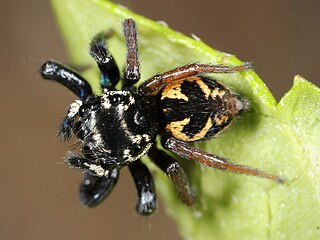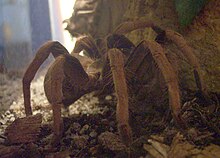
Avicularia is a genus of the family Theraphosidae containing various species of arboreal tarantulas. The genus is native to Panama, the Caribbean and tropical South America. Each species in the genus has very distinguishable pink foot pads.

Corythalia is a genus of jumping spiders that was first described by Carl Ludwig Koch in 1850. The genus is distributed throughout most of the Western Hemisphere. Species of this genus are found in The Americas.

Lycosa is a genus of wolf spiders distributed throughout most of the world. Sometimes called the "true tarantula", though not closely related to the spiders most commonly called tarantulas today, Lycosa spp. can be distinguished from common wolf spiders by their relatively large size. This genus includes the European Lycosa tarantula, which was once associated with tarantism, a dubious affliction whose symptoms included shaking, cold sweats, and a high fever, asserted to be curable only by the traditional tarantella dance. No scientific substantiation of that myth is known; the venom of Lycosa spiders is generally not harmful.

Weinmannia is a genus of trees and shrubs in the family Cunoniaceae. It contains 90 species, which range from Mexico through Central and South America including the Caribbean, and to the Mascarene Islands in the western Indian Ocean. It is absent from mainland Africa and Australia, but some fossils have been attributed to Weinmannia in Australia.

Micrathena, known as spiny orbweavers, is a genus of orb-weaver spiders first described by Carl Jakob Sundevall in 1833. Micrathena contains more than a hundred species, most of them Neotropical woodland-dwelling species. The name is derived from the Greek "micro", meaning "small", and the goddess Athena.

Pamphobeteus is a genus of tarantulas that was first described by Reginald Innes Pocock in 1901. It includes some of the largest spiders in the world. They are found in South America, including the countries of Peru, Bolivia, Ecuador, Brazil, Colombia and Panama.

Psalmopoeus is a genus of the family Theraphosidae containing various species of tarantulas. The genus is native to Trinidad and Tobago, Colombia, Ecuador, Venezuela, Guyana, Brazil, Belize, Panama, Nicaragua, Costa Rica, Mexico, Guatemala and Honduras. All of these tarantulas are arboreal in nature, Psalmopoeus victori being the first arboreal tarantula of Mexico.

The black-tailed myiobius or black-tailed flycatcher is a species of passerine bird in the family Tityridae. It was previously placed in the family Tyrannidae. Black-tailed flycatchers are found in Brazil, Colombia, Costa Rica, Ecuador, Panama, Peru, and Venezuela. Their natural habitats are subtropical or tropical moist lowland forests and heavily degraded former forest. They are usually found alone or in pairs, but may join flocks of several species.

Tarantulas comprise a group of large and often hairy spiders of the family Theraphosidae. As of December 2023, 1,100 species have been identified, with 166 genera. The term "tarantula" is usually used to describe members of the family Theraphosidae, although many other members of the same infraorder (Mygalomorphae) are commonly referred to as "tarantulas" or "false tarantulas". Some of the more common species have become popular in the exotic pet trade. Many New World species kept as pets have setae known as urticating hairs that can cause irritation to the skin, and in extreme cases, cause damage to the eyes.

Neocteniza is a genus of armored trapdoor spiders that was first described by Reginald Innes Pocock in 1895. Originally placed with the Actinopodidae, it was moved to the Idiopidae in 1985.

Olios is the largest genus of huntsman spiders, containing 166 species. They are found throughout the world, with most species occurring in hot countries. The genus was first described by Charles Athanase Walckenaer in 1837.

Acanthoscurria is a genus of tarantulas that was first described by Anton Ausserer in 1871. They are found throughout South America including the countries of Argentina, Bolivia, Brazil, Ecuador, French Guiana, Guyana, Paraguay, Peru, Suriname and Venezuela, plus into the Windward Islands West Indies,.

Sericopelma is a genus of tarantula, found in Central America from Nicaragua to Panama. The limits of the genus and its distribution have long been confused; it is closely related to the genus Aphonopelma. Sericopelma species are among the largest found in Central America. They can be kept as pets, although at least one species has been described as "very aggressive".

Ctenus is a genus of wandering spiders first described by Charles Athanase Walckenaer in 1805. It is widely distributed, from South America through Africa to East Asia. Little is known about the toxic potential of the genus Ctenus; however, Ctenus medius has been shown to share some toxic properties with Phoneutria nigriventer, such as proteolytic, hyaluronidase and phospholipase activities, in addition to producing hyperalgesia and edema. The venom of C. medius also interferes with the complement system in concentrations in which the venom of P. nigriventer is inactive, indicating that some species in the genus may have a medically significant venom. The venom of C. medius interferes with the complement component 3 (C3) of the complement system; it affects the central factor of the cascades of the complement, and interferes with the lytic activity of this system, which causes stronger activation and consumption of the complement components. Unlike C. medius, the venom of P. nigriventer does not interfere with lytic activity.
Synotaxus is a genus of araneomorph spiders in the family Synotaxidae that was first described by Eugène Louis Simon in 1895. Originally placed with the tangle web spiders, it was moved to the family Synotaxidae in 2017.
Pronous is a genus of South American and African orb-weaver spiders first described by Eugen von Keyserling in 1881.
Metagonia is a genus of cellar spiders that was first described by Eugène Louis Simon in 1893.

















